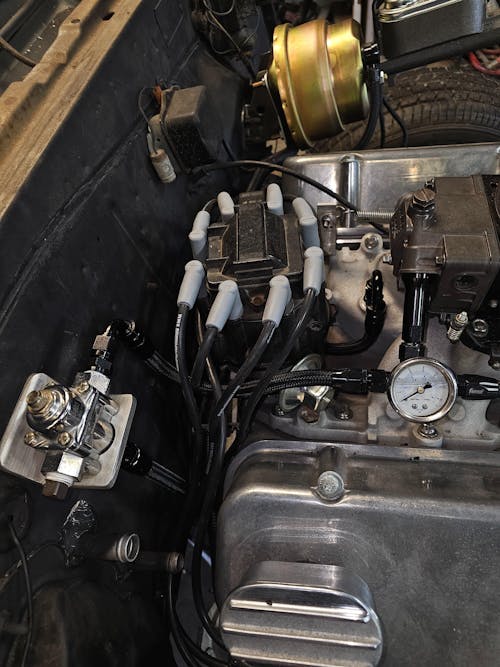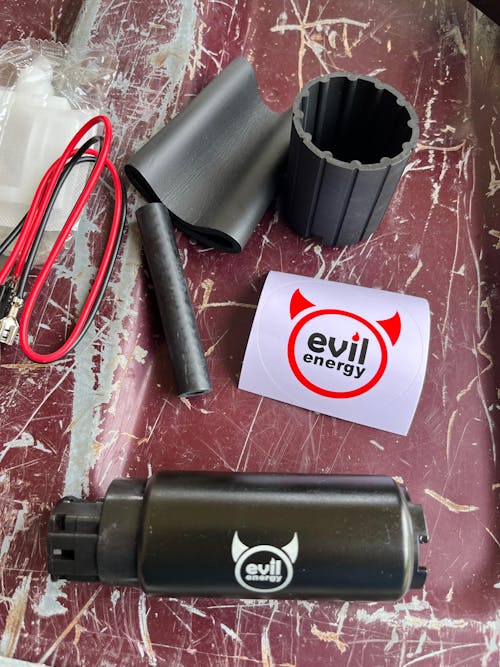500 CFM vs 650 CFM: Choosing Between Cruising Economy and Street Performance
Introduction: Why a 650 CFM carburetor isn't for Everyone
When all the performance forums are buzzing about 650 CFM carburetors, you might feel that 500 CFM is an 'outdated' or 'too small' choice. You might think, isn't bigger always better?
The reality is just the opposite. For a specific engine and a specific purpose, a 500 cfm carburetor is often a smarter, more precise choice. The crisp throttle response and driving pleasure it provides are often unmatched by an oversized 650 CFM carburetor.
This article will dive deep into the 500 CFM vs 650 CFM matchup to help you decide: should you chase the 'maximum horsepower' of a 650 CFM, or choose the 'optimal response and efficiency' of a 500 CFM?
The 'Sweet Spot' for 500 CFM carburetor: Who Is It For?
A 500 CFM carburetor isn't a performance compromise; it's a precision-matched component. Its core audience is very specific:
Small V8 Engines (Small V8s)
This is the core market for the 500 cfm carburetor. We're talking about V8 engines like 283, 302 (5.0L), 305, or 307 cubic inches. For stock or mildly modified versions of these engines, a 650 cfm carburetor is often simply too large. A 500 CFM carb perfectly matches their cylinder volume, generating high air velocity for optimal fuel atomization.
Cruising vs. Racing
Is your goal to get crisp throttle response and the best possible fuel economy in city driving? Does your engine spend the vast majority of its time below 5500 RPM? If the answer is yes, the 500 CFM is designed for you. It performs best in the low-to-mid RPM range where your engine lives.
Restoration & Reliability
Are you restoring a classic car and want it to drive as smoothly and reliably as it did when it was new, rather than like an untamable beast? A 500 CFM provides a smooth idle, linear throttle, and reliable cold starts. Modern models, especially like the Evil Energy 500 CFM Carburetor, are ideal for classic car restorations, offering excellent convenience and reliability.
The Cost of a Mismatch: Two Common Mistakes
Choosing the wrong CFM can cause a lot of problems. Here are the two most common 'user pain points':
Error 1: Using a 650 CFM on a 302 Engine (Too Large)
-
Symptoms: This is similar to the 'over-carbed' issue we discussed in our 650 CFM vs 750 CFM Carburetor article. At low speeds, the throttle response is sluggish, feeling 'mushy.' The vehicle feels weak off the line and has a slight 'bog' when you step on the gas. Most importantly, your fuel economy will be poor.
-
Reason: The engine's 'lung capacity' is too small to generate enough air velocity through the large bores of a 650 CFM at low RPM. This slow-moving air cannot effectively atomize the fuel from the jets.
Error 2: Using a 500 CFM on a 350 Performance Engine (Too Small)
-
Symptoms: It feels fantastic driving around town (2000-4000 RPM)—incredibly responsive, maybe even better than a 650 CFM.
-
The Problem: When you get on the highway or try to accelerate hard, as soon as the RPMs climb past 4500 RPM (or higher, depending on mods), the engine feels like it 'hit a wall.' It will 'choke' because the engine needs more air, but the 500 cfm carburetor has already reached its maximum flow limit, and power will drop off sharply.
-
Reason: The engine's air demand has exceeded the carburetor's maximum supply.
Decision Guide: Should You Choose 500 or 650?
So, when faced with 500 CFM vs 650 CFM, what do you choose? Refer to the decision table below:
| Decision Factor | Choose 500 CFM (Efficiency) | Choose 650 CFM (Performance) |
| Engine Displacement | 305 c.i. (5.0L) & Below | 350 c.i. (5.7L) & Above |
| Primary Use | Daily Driving, Long-Distance Cruising, Classic Car Restoration | Street Performance, Weekend Racing, Muscle Cars |
| Target RPM Range | Idle - 5500 RPM | Idle - 6500 RPM |
| Engine Mods | Stock or Mild (Intake/Exhaust only) | Has Camshaft, Heads, or Intake Manifold Upgrades |
| Priority | Fuel Economy & Low-Speed Response | Mid-to-High RPM Horsepower & Torque |
Conclusion: Choose for Your Goal, Not the 'Number'
In the 500 CFM vs 650 CFM debate, there is no absolute 'winner,' only the 'best fit.' Don't buy a 650 just because it sounds like a bigger 'performance' number.
-
If you have a beautiful classic car with a 302 V8 and you want it to be smooth, fuel-efficient, and responsive, a 500 cfm carburetor is your smart choice.
-
If you have a modified 350 V8 and you want to 'light up the tires' at a stoplight, a 500 CFM will leave you completely disappointed—you need the full potential that a 650 cfm carburetor can unleash.
Choose the right tool for your driving goal, and you'll get the best driving experience.
FAQs about 500 CFM vs 650 CFM carburetor
Q1: Isn't a 500 CFM carburetor too small for a V8 engine?
A1: Not necessarily. For small V8 engines (like 305 c.i., 302 c.i., 283 c.i.), especially in vehicles used for daily cruising and fuel economy, a 500 cfm carburetor is often the ideal choice. Its smaller venturis create higher air velocity at low-to-mid RPMs, resulting in much crisper throttle response and better fuel atomization.
Q2: Can I use a 500 CFM carburetor on my 350 engine?
A2: You can, but it will severely restrict your engine's performance potential. As mentioned in the article, your 350 will feel responsive at low RPMs, but it will 'choke' or 'hit a wall' at higher RPMs (usually above 4500 RPM) because the carburetor cannot supply enough air. If you have a 350 engine and want the horsepower it's capable of, a 650 cfm carburetor is the proper starting point.
Q3: How big a difference is there in fuel economy between a 500 CFM and 650 CFM carb?
A3: The difference can be significant. On a small V8, a properly matched 500 cfm carburetor will almost always provide noticeably better fuel economy due to its efficient atomization. Using an oversized 650 cfm carburetor on that same engine will cause poor atomization, forcing the engine to run rich (too much fuel) and wasting gas.
Q4: Should I choose a vacuum secondary or a mechanical secondary 650 CFM carburetor?
A4: This depends on your vehicle and use. For most street cars, especially those with automatic transmissions, a vacuum secondary 650 cfm carburetor is the better choice. It opens the secondary barrels smoothly based on engine load (vacuum signal), making power delivery smoother and more drivable. Mechanical secondaries (where the secondaries are opened directly by your foot on the gas pedal) are better suited for lighter, high-performance street/strip cars, usually with manual transmissions, that are looking for maximum off-the-line acceleration.
About EVIL ENERGY Carburetor
EVIL ENERGY's mission is simple: to break the convention of the high-performance auto parts market being dominated by a few high-priced brands. We firmly believe that excellent performance should not come with a hefty brand premium. But we know that choosing the right EVIL ENERGY Carburetor is more than just buying a part; it's a critical decision. You might be asking: 'How Does a Carburetor Work?' 'How to Choose the Best Carburetor for Your Engine?' or 'How to Choose the Right Carburetor for a Chevy 350 (SBC) Engine?' This is what makes EVIL ENERGY different. We don't just offer carburetors with performance that rivals competitors at a more competitive price; we are your knowledge resource. Are you debating 'Holley VS EVIL ENERGY'? We have the comparison. Need to know 'How to Install a Carburetor?' We have the full tutorial. Our entire EVIL ENERGY Carburetor is 100% brand new (never rebuilt), Engineered for High Performance, and Ready for Easy Installation (Factory Replacement Ready). It's time to stop paying a premium for an old logo. When you choose EVIL ENERGY, you're not just getting a high-value, brand-new EVIL ENERGY Carburetor; you're getting the complete tutorials and support needed to finish your project.
-
Website: https://www.ievilenergy.com/
-
TikTok: @evil_energy_autoparts
-
YouTube: @ievilenergy
-
Instagram: @evil_energy_autoparts
-
Facebook: EvilEnergyRacing
-
Contact Us: support@evilenergy.com




![[20FT] EVIL ENERGY PTFE Fuel Line Kit, complete black hose & fittings set, 180-day return](http://www.ievilenergy.com/cdn/shop/files/Test-2025-Evilenergy-125598065_165x.png?v=1742144807)
![[16FT] EVIL ENERGY PTFE Fuel Line Kit, black braided hose, fittings, free shipping & return](http://www.ievilenergy.com/cdn/shop/files/Test-2025-Evilenergy-125598171_165x.png?v=1742144807)
![CPE Fuel Line[25FT]](http://www.ievilenergy.com/cdn/shop/files/25FTCPE_FuelLine_165x.png?v=1735220649)
![CPE Fuel Line[20FT]](http://www.ievilenergy.com/cdn/shop/files/20FTCPE_FuelLine_165x.png?v=1735220649)















